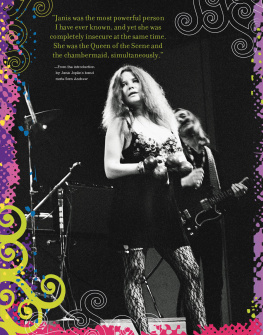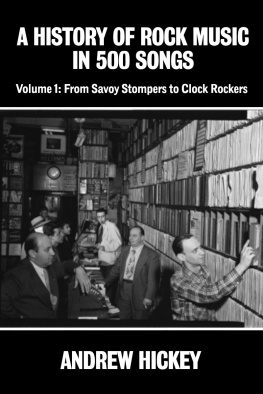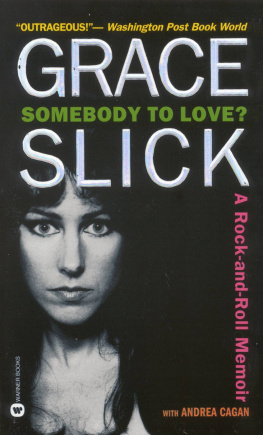INTRODUCTION
Rock n roll is built of fierce women. Blues, jazz, R&B, and country artists who laid its groundwork. Girl groups who projected a flashy, united front. Counterculture singers who protested the establishment. Punk rockers who democratized music-making. Riot grrrls who politicized it. And so many more. They all subverted stereotypes and challenged expectations, whether they set out to or not. Their rebellion is empowering and exponential.
So how does one choose the 50 fiercest? If I covered all the consequential female musicians I wanted to include, Id still be writing this book, and you wouldnt be holding it.
Every woman on the pages that follow made an original, influential, and indelible mark on music and culture. Some are famous and sold millions of albums. Others are less well-known, their impact much like whats often said of the Velvet Underground: Only a few bought their records, but everyone who did started a band. Each of these women steadfastly carved out a place for herself as an artist. They made it look easy, but, as youll soon read, it wasnt. Some battled those who told them it couldnt be done. Others fought addiction and abuse. The challenges each faced are inexorably linked with her achievements. Their stories are inspirational, and their art is timeless.
As it was impossible to condense these womens lives and careers into single chapters, I aimed instead to tell you some stories you may not have heard and introduce you to some artists you might not have met. I sought to celebrate the accomplishments of these extraordinary musicians and find the connective threads between themthe common experiences they share as women in music and the effect theyve had on one another.
To expand on that, in each chapter youll see other artists named who either influenced or were influenced by the fierce 50. I wasnt able to devote more space to them in this book, but they still deserve a place in the canon. Youll also find a selection of Deep Cutssuggested listening beyond the hits you already know (though for the more obscure artists, even their hits qualify).
Rock-and-Roll Woman is written in the spirit of exploration. Its arranged chronologically but can be read randomly; it will still make sense if you open up to any particular musician and see where that takes you. I hope you enjoy spending time with these phenomenal women as much as I did.
SISTER ROSETTA THARPE
BORN: Rosetta Nubin / March 20, 1915 / Cotton Plant, Arkansas DIED: October 9, 1973 / Philadelphia
Sister Rosetta Tharpe playing with the Lucky Millinder Orchestra, c. 1938.
INFLUENCES: Memphis Minnie, Bessie Smith, Ma Rainey, Jesus Christ
INFLUENCED: All of rock n roll
DEEP CUTS: The Devil Has Thrown Him Down / Strange Things Happening Every Day / Ninety-Nine and a Half Wont Do (with Katie Bell Nubin)
When the Rock and Roll Hall of Fame announced that the class of 2018 would include Sister Rosetta Tharpe, it had been a staggering eighty years since she made her first record. A one-woman ministry of American music, Tharpe brought gospel into the secular world with an ecstatic voice and canny allusion, and she wielded an electric guitar in consecrated halls. She was sanctified, amplified, and gratified. Tharpes wild style and rebellious nature influenced the earliest rock n rollers. If Elvis Presley, Chuck Berry, Little Richard, and Jerry Lee Lewis are cornerstones of rock, Tharpe is its foundation.
Little Rosetta was still in her single digits when she started performing in church, a tiny phenom with indelible power. Her mother, Katie Bell Nubin, was an evangelist for the Church of God in Christ, a Holiness-Pentecostal denomination that encouraged music as a form of spiritual expression and proselytizing. Founded by Charles Price Jones, credited with writing more than a thousand hymns, and Charles Harrison Mason, a son of former slaves who recognized the need to minister to African Americans moving around the country before World War II, the church created holy-rolling road shows that would give Tharpe her first taste of touring.
Tharpes wild style and rebellious nature influenced the earliest rock n rollers.
With her six-year-old daughter in tow, Katie Nubin left Arkansas for Chicago, part of the Great Migration. Rosetta soaked up the urban noise of her environs. In the 30s, she became one of the first to adopt a then-new electric guitar, which she played loud enough to cut through any clamor and distorted enough to heavily influence the sound of rock n roll. As a teenager, Rosetta went on a mission with her mother, traveling the country to play black churches and uplift worshipers with her bold voice and stage presence. At nineteen, she married Tommy Thorpe, an imperious Church of God in Christ pastor whod been part of their evangelical tour, but Sister Rosetta, as she was now called, was indomitable. The marriage didnt last, but she kept his name, with a slight change.














